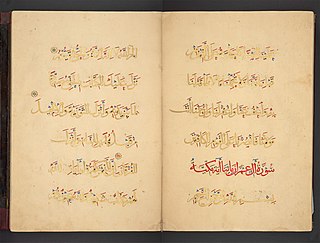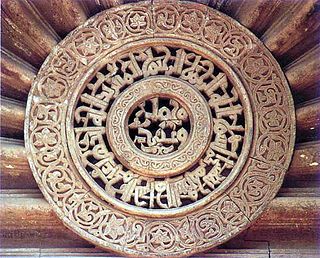
In religion, a prophet or prophetess is an individual who is regarded as being in contact with a divine being and is said to speak on behalf of that being, serving as an intermediary with humanity by delivering messages or teachings from the supernatural source to other people. The message that the prophet conveys is called a prophecy.
Mūsā ibn ʿImrān is a prominent prophet and messenger of God and is the most frequently mentioned individual in the Quran, with his name being mentioned 136 times and his life being narrated and recounted more than that of any other prophet. He is one of the most important prophets and messengers of Islam.

The Israʾ and Miʿraj are the two parts of a Night Journey that Muslims believe the Islamic prophet Muhammad took during a single night around the year AD 621. Within Islam, "the majority" of scholars agree that the journey was both a physical and spiritual one. A brief mention of the story is found in the 17th surah (chapter) of the Quran, called al-Isra', while details of the story are found in the hadith.

Al Imran is the third chapter (sūrah) of the Quran with two hundred verses (āyāt).

Ahl al-Bayt refers to the family of the Islamic prophet Muhammad, but the term has also been extended in Sunni Islam to all descendants of the Banu Hashim and even to all Muslims. In Shia Islam, the term is limited to Muhammad, his daughter Fatima, his cousin and son-in-law Ali ibn Abi Talib, and their two sons, Ḥasan and Husayn. A common Sunni view adds the wives of Muhammad to these five.

The Siyer-i Nebi is an Ottoman epic on the life of Muhammad, completed around 1388, written by Mustafa, a Mevlevi dervish on the commission of Sultan Barquq, the Mamluk ruler in Cairo. The text is based on the 13th-century writings of Abu’l Hasan al-Bakri and Ibn Hisham. This epic would later be illustrated by Mustafa ibn Vali in the late 16th century by his patron, Sultan Murad III.

In some forms of Islamic art, aniconism (the avoidance of images of sentient beings) stems in part from the prohibition of idolatry and in part from the belief that the creation of living forms is God's prerogative.

The Jāmiʿ al-tawārīkh is a work of literature and history, produced in the Mongol Ilkhanate. Written by Rashid al-Din Hamadani at the start of the 14th century, the breadth of coverage of the work has caused it to be called "the first world history". It was in three volumes and published in Arabic and Persian versions.

The permissibility of depictions of Muhammad in Islam has been a contentious issue. Oral and written descriptions of Muhammad are readily accepted by all traditions of Islam, but there is disagreement about visual depictions. The Quran does not explicitly or implicitly forbid images of Muhammad. The ahadith present an ambiguous picture, but there are a few that have explicitly prohibited Muslims from creating visual depictions of human figures. It is agreed on all sides that there is no authentic visual tradition as to the appearance of Muhammad, although there are early legends of portraits of him, and written physical descriptions whose authenticity is often accepted.
Sabiha Al Khemir or Sabiha Khemir is a Tunisian writer, illustrator, and expert in Islamic art, whose work is concerned with cultural bridging and cultural dialogues. She was the founding director of the Museum of Islamic Art in Doha, Qatar. She was born in Tunisia and grew up in Korba, Tunisia, where she attended Koranic school as a child. She is fluent in and lectures internationally in English, Arabic and French in addition to speaking Italian and Spanish. Her multifaceted approach has been widely recognized. She is known for using themes relating to the metropolitan location and identity in her literature and art.

The Persian word Falnama covers two forms of bibliomancy used historically in Iran, Turkey, and India. Quranic Falnamas were sections at the end of Quran manuscripts used for fortune-telling based on a grid. In the 16th century, Falnama manuscripts were introduced that used a different system; individuals performed purification rituals, opened a random page in the book and interpreted their fortune in light of the painting and its accompanying text. Only a few illustrated Falnamas now survive; these were commissioned by rich patrons and are unusually large books for the time, with bold, finely executed paintings. These paintings illustrate historical and mythological figures as well as events and figures associated with the Abrahamic religions.
Prophets in Islam are individuals in Islam who are believed to spread God's message on Earth and to serve as models of ideal human behaviour. Some prophets are categorized as messengers, those who transmit divine revelation, most of them through the interaction of an angel. Muslims believe that many prophets existed, including many not mentioned in the Quran. The Quran states: "And for every community there is a messenger." Belief in the Islamic prophets is one of the six articles of the Islamic faith.

The doctrine of the Imamate in Isma'ilism differs from that of the Twelvers because the Isma'ilis had living Imams for centuries after the last Twelver Imam went into concealment. They followed Isma'il ibn Ja'far, elder brother of Musa al-Kadhim, as the rightful Imam after his father, Ja'far al-Sadiq. The Ismailis believe that whether Imam Ismail did or did not die before Imam Ja'far, he had passed on the mantle of the imamate to his son Muhammad ibn Isma'il as the next imam.
In Islam, Hārūn ibn ʿImrān, the Biblical Aaron, is a prophet and messenger of God, and the older brother of the prophet Mūsā (Moses). He along with his brother (Moses) preached the Israelites to the Exodus.

The Great Mongol Shahnameh, also known as the Demotte Shahnameh or Great Ilkhanid Shahnama, is an illustrated manuscript of the Shahnameh, the national epic of Greater Iran, probably dating to the 1330s. In its original form, which has not been recorded, it was probably planned to consist of about 280 folios with 190 illustrations, bound in two volumes, although it is thought it was never completed. It is the largest early book in the tradition of the Persian miniature, in which it is "the most magnificent manuscript of the fourteenth century", "supremely ambitious, almost awe-inspiring", and "has received almost universal acclaim for the emotional intensity, eclectic style, artistic mastery and grandeur of its illustrations".

The Khalili Collection of the Hajj and the Arts of Pilgrimage is a private collection of around 5,000 items relating to the Hajj, the pilgrimage to the holy city of Mecca which is a religious duty in Islam. It is one of eight collections assembled, conserved, published and exhibited by the British-Iranian scholar, collector and philanthropist Nasser Khalili; each collection is considered among the most important in its field. The collection's 300 textiles include embroidered curtains from the Kaaba, the Station of Abraham, the Mosque of the Prophet Muhammad and other holy sites, as well as textiles that would have formed part of pilgrimage caravans from Egypt or Syria. It also has illuminated manuscripts depicting the practice and folklore of the Hajj as well as photographs, art pieces, and commemorative objects relating to the Hajj and the holy sites of Mecca and Medina.

A sitara or sitarah is an ornamental curtain used in the sacred sites of Islam. A sitara forms part of the kiswah, the cloth covering of the Kaaba in Mecca. Another sitara adorns the Prophet's Tomb in the Al-Masjid an-Nabawi mosque in Medina. These textiles bear embroidered inscriptions of verses from the Quran and other significant texts. Sitaras have been created annually since the 16th century as part of a set of textiles sent to Mecca. The tradition is that the textiles are provided by the ruler responsible for the holy sites. In different eras, this has meant the Mamluk Sultans, the Sultans of the Ottoman Empire, and presently the rulers of Saudi Arabia. The construction of the sitaras is both an act of religious devotion and a demonstration of the wealth of the rulers who commission them.

The Nasser D. Khalili Collection of Islamic Art includes 28,000 objects documenting Islamic art over a period of almost 1400 years, from 700 AD to the end of the twentieth century. It is the largest of the Khalili Collections: eight collections assembled, conserved, published and exhibited by the British-Iranian scholar, collector and philanthropist Nasser David Khalili, each of which is considered among the most important in its field. Khalili's collection is one of the most comprehensive Islamic art collections in the world and the largest in private hands.

Jamal al-Din bin Muhammad Saeed bin Qasim al-Hallaq al-Qasimi was the organizer of the story of Kalila and Dimna. He was one of the pioneers of the modern scientific and religious renaissance movement in the modern era of the Levant. According to his followers, he was one of the great Muslim scholars in the first half of the 14th century AH, and authored many valuable books that helped various scholars and students.
















